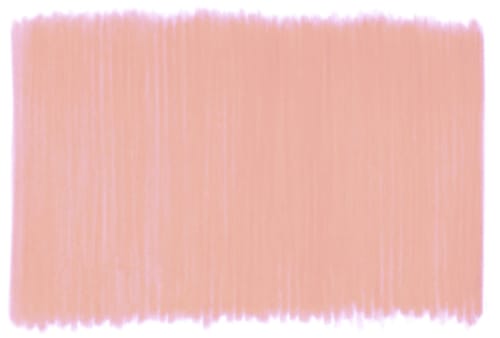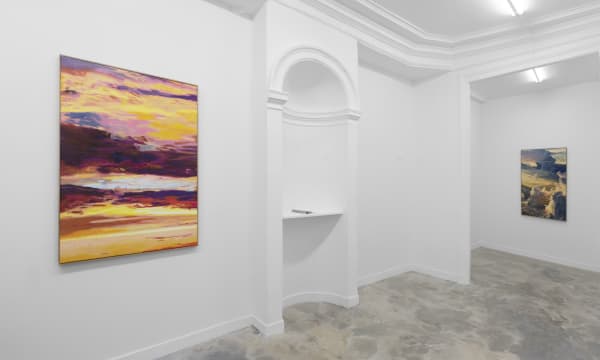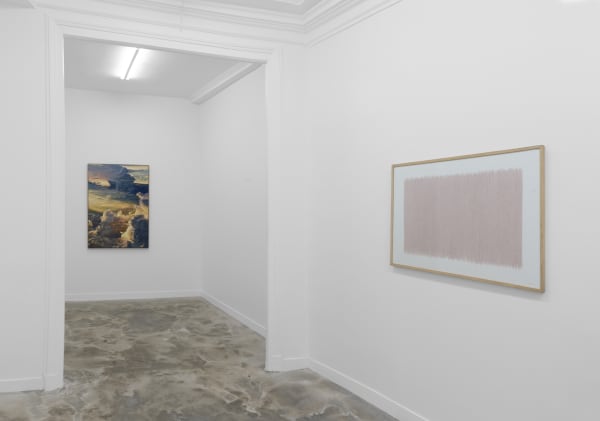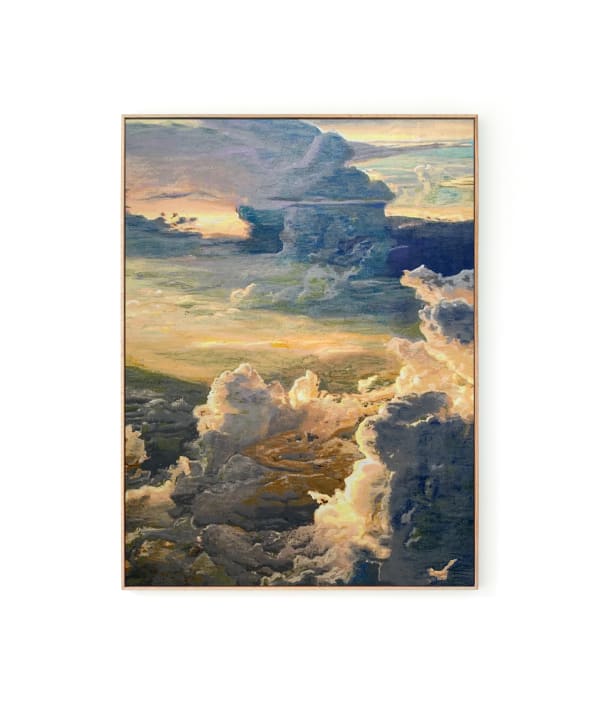TOUCHER L'HORIZON: ADAM BOGEY | HERMAN DE VRIES
Past exhibition
Overview
À l’heure où la distance est de mise, à celle où la terre et les cieux résument un environnement planétaire meurtrit, à celle réactualisant les dures crises sanitaires que l’humanité a toujours traversé, il a semblé primordial de revenir à cet « essentiel », qui, subitement, est (re)devenu fédérateur. Et, alors que le quotidien devenu bancal cherche sa place, l'urgence d'observer les fondamentaux comme tels gronde toujours. Les sols que nos pas foulent, les nuages qui continuent leur calme course, le commun, dans la pluralité de ses sens, semble, curieusement à réapprendre. Ce commun admis que l’on ne regardait plus semble hurler à la non-invisibilisation, ce commun partagé sans qu’il ne s’envisage n'acceptera plus le silence. Celui-là même qui résume la base de tout et qui fera dire à herman de vries « all this here », celui-là, l'art en accueille le reflet.
C'est ainsi qu'accoler les cieux de l’artiste franco-mexicain Adam Bogey aux terres du néerlandais herman de vries renvoient aux deux points d’acmés primordiaux qui ont tracé ce monde si beau, aujourd’hui encore apeuré. L’en-haut et l’en-bas, origines de tous les mythes, en sont certainement la substance première. Ici, entre les deux artistes, Gaïa, la terre-mère créatrice retrouve Ouranos, dieu du Ciel et de l’Esprit dans une idée atemporelle d’union au seul lien perceptible. A eux deux, ils résument le commencement de tout et enfantent d'un lien fragile que le visiteur devra tendre seul : l'horizon.
Du côté de l'en-haut, la série « Fuegos » d’Adam Bogey trouve dans ses aplats de couleurs, myriade de références à sa double nationalité. Les chaudes teintes qu’il emploie s’exhument des pigments préhispaniques, des fresques de Diego Rivera, et de la douceur de Claude Monet ; mais renvoient à des leviers plus durs et plus actuels. Cette série émerge lorsqu’il assiste, en 2019, impuissant aux côtés de l’ensemble de la planète, aux terribles feux ayant détruit l’Australie et l’Amazonie. Basses, torturées, déchirées, ces trainées de couleurs se chargent des frayeurs contemporaines d’une nature au désespoir qui fascine depuis toujours et que les musées, depuis des siècles, ne cessent d'accrocher à leurs murs. Le sentiment du sublime que l’on peut retrouver dans les toiles de Claude Lorrain ou Turner et dans les études de ciel de Delacroix fait alors étrangement écho au kitsch de l’assourdissante base iconographique des photographies de coucher de soleil que les débuts de l’ère numérique ont largement exploité. Fantasmé à outrance, cet espace lointain, omniprésent et si vaste qu'est le ciel est ici réduit à une respiration primaire, brute et parfois grossière, celle d’un pastel gras qui trace un mystérieux mélange.
Ce que l’on pourrait envisager comme un rappel au tracé préhistorique apparaît autrement dans le geste essentiel de la main d’herman de vries. A la surface des From earth, sur du papier, il saupoudre de la terre issue de divers endroits du monde et l’étale, du bout des doigts (majoritairement du pouce), en des mouvements droits et réguliers. Cet effleurement engage un comportement qui devrait résonner en chacun d’entre nous : caresser, prendre conscience et contempler le sol sur lequel nous marchons. L’artiste, par ce geste rituelique, sacralise ce qu’il touche et offre à voir. En extrayant la banalité supposée de ce que l’on a tendance à enfermer sous le béton, en le portant au mur, il lui redonne toute l’étendue de son importance.
Bogey et de vries se rejoignent en un message s’étalant au-delà même de considération écologique. Ils forcent à s’arrêter sur ce qui, bien qu’immensément complexe, s’envisage encore insensément pour certains comme quelque chose à conquérir : le ciel et la terre. Par leurs touches respectives, chacun à une extrémité de l'athmosphère, l’un proche du post-impressionnisme, l’autre du minimalisme, Bogey et de vries rappellent qu’il est important de réactualiser le statut d’un artiste passeur du réel, pour pouvoir mieux s’y attarder.
Sandra Barré
At a time when distance is the order of the day, when the earth and the skies sum up a bruised planetary environment, at a time when the harsh health crises that humanity has always endured are being updated, it seemed essential to return to this 'essential', which has suddenly (re)become a unifying force. And while our everyday lives have become shaky and we're trying to find our place, there's still an urgent need to look at the fundamentals themselves. The ground that our feet tread, the clouds that continue their calm course, the common, in the plurality of its meanings, seems, curiously enough, to be relearning. This accepted commonality that we no longer look at seems to be crying out for non-invisibilisation, this shared commonality that cannot be envisaged will no longer accept silence. The very thing that sums up the basis of everything, and that made Herman de Vries say "all this here", is reflected in art.
The skies of Franco-Mexican artist Adam Bogey and the lands of Dutch artist Herman de Vries are reminiscent of the two primordial acme points that have shaped this beautiful world, which is still frightened today. Above and below, the origins of all myths, are certainly its primary substance.
Here, between the two artists, Gaia, the creative mother earth, meets Ouranos, the god of Heaven and Spirit, in a timeless idea of union with the only perceptible link. Between them, they sum up the beginning of everything and give birth to a fragile link that visitors will have to stretch themselves: the horizon. Adam Bogey's 'Fuegos' series, with its flat tints of colour, contains a myriad of references to his dual nationality. The warm hues he employs draw on pre-Hispanic pigments, the frescoes of Diego Rivera, and the softness of Claude Monet; but they also evoke harsher, more contemporary influences. This series emerged in 2019, when he witnessed the terrible fires that destroyed
Australia and the Amazon, powerless alongside the rest of the planet. Low, tortured, torn, these streaks of colour are charged with the contemporary fears of a despairing nature that has always fascinated and that museums have been hanging on their walls for centuries. The sense of the sublime to be found in the paintings of Claude Lorrain or Turner and in Delacroix's studies of the sky echoes strangely with the kitsch of the deafening iconographic base of the sunset photographs that the beginnings of the digital era exploited to great effect. The distant, omnipresent and vast space that is the sky, fantasised to excess, is here reduced to a primary, crude and sometimes coarse breath, that of an oil pastel tracing a mysterious blend.
What might be seen as a reminder of prehistoric tracing appears differently in the essential gesture of herman de vries' hand. On the surface of From earth, on paper, he sprinkles earth from different parts of the world and spreads it with his fingertips (mostly his thumb) in straight, regular movements. This effleurement engages a behaviour that should resonate with each and every one of us: caressing, becoming aware of and contemplating the ground on which we walk. Through this ritual gesture, the artist makes sacred what he touches and offers to be seen. By extracting the supposed banality of what we tend to enclose in concrete, and bringing it to the wall, he gives it back the full extent of its importance.
Australia and the Amazon, powerless alongside the rest of the planet. Low, tortured, torn, these streaks of colour are charged with the contemporary fears of a despairing nature that has always fascinated and that museums have been hanging on their walls for centuries. The sense of the sublime to be found in the paintings of Claude Lorrain or Turner and in Delacroix's studies of the sky echoes strangely with the kitsch of the deafening iconographic base of the sunset photographs that the beginnings of the digital era exploited to great effect. The distant, omnipresent and vast space that is the sky, fantasised to excess, is here reduced to a primary, crude and sometimes coarse breath, that of an oil pastel tracing a mysterious blend.
What might be seen as a reminder of prehistoric tracing appears differently in the essential gesture of herman de vries' hand. On the surface of From earth, on paper, he sprinkles earth from different parts of the world and spreads it with his fingertips (mostly his thumb) in straight, regular movements. This effleurement engages a behaviour that should resonate with each and every one of us: caressing, becoming aware of and contemplating the ground on which we walk. Through this ritual gesture, the artist makes sacred what he touches and offers to be seen. By extracting the supposed banality of what we tend to enclose in concrete, and bringing it to the wall, he gives it back the full extent of its importance.
Bogey and de Vries are united in a message that goes beyond ecological considerations. They force us to stop and think about what, although immensely complex, is still seen by some as something to be conquered: the sky and the earth. With their respective brushstrokes, each at one end of the athmosphere, one close to post-impressionism, the other to minimalism, Bogey and de vries remind us that it is important to update the status of an artist as a passer-by of reality, so as to be better able to linger on it.
Sandra Barré
Installation Views
Works








